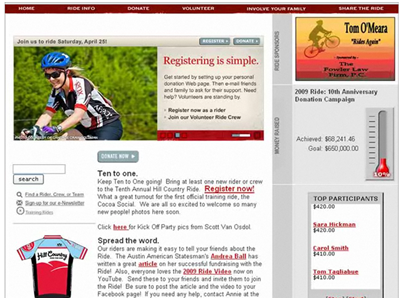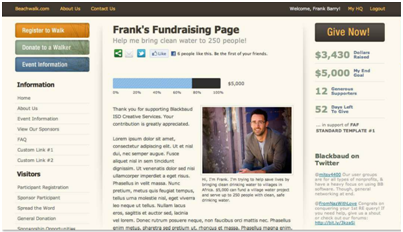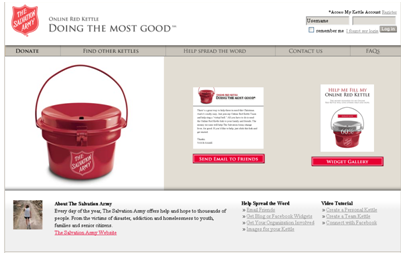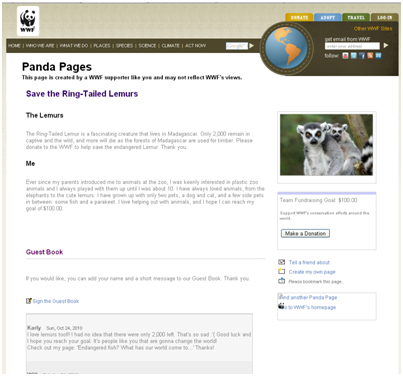- Basics: We’ve talked about Kickstarter before and it is one of the most popular crowdfunding tools. Users have two months to raise funds and provide rewards to their patrons. Kickstarter’s guidelines specifically state you cannot use Kickstarter to fund a charity - you can, however, use it to fund projects for a non-profit. For example, No-Space of Brooklyn used Kickstarter to fund the move to and costs associated with their forced relocation.
- Pros: Kickstarter has an “all or nothing” platform, if funds are not raised within the 60 day limit, all pledges are dropped. Kickstarter is well known and a fairly safe bet for those looking to fund their first project.
- Cons: The project-centric ideology limits what can be crowdfunded. Also, Kickstarter uses Amazon Payments. While Kickstarter itself does not require those creating projects to be US citizens, Amazon Payments does, which makes Kickstarter out of the reach of international organizations.
- Fees: Kickstarter charges a 5% fee to successful projects. There is also a 3-5% fee associated with credit card transactions on successful projects.
- Basics: USA Projects is another crowdfunding source we’ve discussed before, and it is a project of USA Artists. Potential projects have three months to raise the funds or receive nothing. The Project sponsors “new creative efforts by accomplished artists across the country” and has raised over $1 million so far. All suggested projects are vetted by artistic experts in the related field.
- Pros: USA Projects has a strong institutional background with USA Artists, allowing it to have a gift-matching component, and the average donor gives more than Kickstarter users. All donations are tax-deductible, and artists offer perks for donating.
- Cons: USA Projects only accepts artist members who have previously received a grant or award from their partner and recognized organizations as an individual artist.
- Fees: 19% of all donations go to USA Projects “for use in furthering its general charitable and educational purposes.”
- Basics: IndieGoGo touts itself as “the world’s leading international funding platform”, and is open to “anybody with a great idea”. Projects are not curated. Users have up to 120 days to reach their goal, but unrealized goals still receive the pledged funds.
- Pros: Donations to non-profit organizations on IndieGoGo are tax-deductible, different donor levels have perks related to the campaign. Analytics tools allow campaign managers to track where/who funds are coming from, as well as capture contact information from funders. Anyone can use IndieGoGo for anything, which is has unlimited possibilities. IndieGoGo also has partnerships with non-profit organizations that fiscally sponsor projects.
- Cons: No vetting process on campaigns means your next big, great idea may not carry as much weight for donors as a website where projects are curated. Also the website caters more to individual artists’ projects than arts organizations - arts campaigns are not listed under “Causes” unless they have an educational component.
- Fees: IndieGoGo takes 4% of the money your project manages to raise, if your goal is met. Should your project fall short, IndieGoGo takes a 9% cut of funds raised. International campaigns may have higher fees.
- Basics: RocketHub is a crowdfunding platform for anyone who would like their creative work to be funded, developed or distributed. RocketHub has two levels of fundraising, one is a crowdfunding tool open to anyone. Campaigns have between 15 and 90 days to be funded, unrealized goals will still be funded, but met goals have rewards within RocketHub. The second is called a “LaunchPad Opportunity”, which is a reoccuring vetted submission process. Projects chosen receive an opportunity that will advance their business or campaign beyond simple fundraising (for example, the winner of the LaunchPad Opportunity will work with an expert publicist on generating buzz for their project). A team of judges at RocketHub examines all submissions, and Facebook users vote to help decide which projects to put on the website to fund.
- Pros: Successfully funded campaigns on RocketHub allow the campaign creator to submit 5 entries to their LaunchPad Opportunities without a cost. RocketHub has partnerships with non-profit organizations that fiscally sponsor projects.
- Cons: RocketHub does not have a specific “Art” category, although individual projects could fit well into their other categories.
- Fees: For crowdfunded fees, RocketHub charges 4% of the money you raise if your goal is met. For unfunded projects, the fee is 8%. RocketHub also charges a 4% transaction fees for credit card charges. For first time submitters to a “LaunchPad Opportunity”, there is a submission fee of $8. Those who have a project successfully crowdfunded do not have this fee.
IndieGoGo and RocketHub work outside the states, but there are other crowdfunding tools internationally. There are also tools like Philanthroper, which is a daily deal crowdfunding site for non-profit organizations. There are resources for staying on top of crowdsourcing trends, too. Ultimately, an individual or organization has to consider what type of crowdfunding campaign will work for their needs before deciding on one. If there are any other crowdfunding topics or questions you’d like answered, leave a comment, and we’ll see how we can help.









